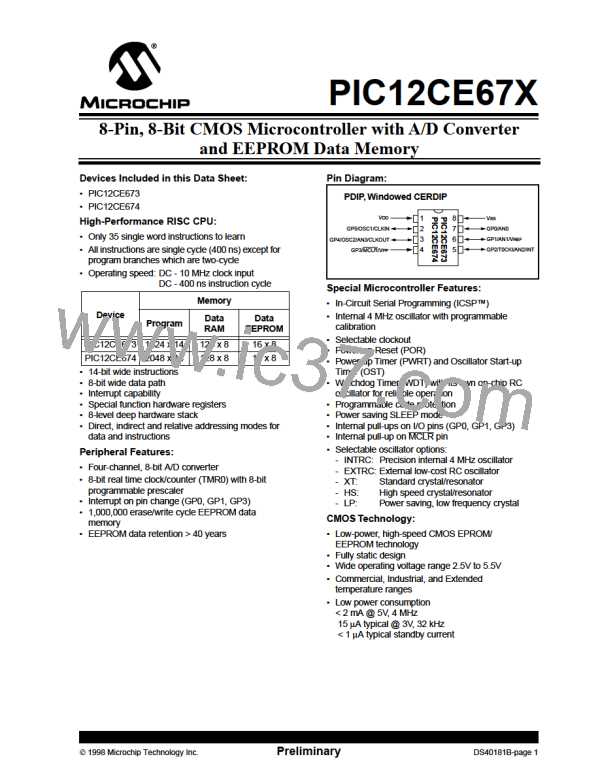PIC12CE67X
The ADRES register contains the result of the A/D con-
version. When the A/D conversion is complete, the
result is loaded into the ADRES register, the GO/DONE
bit (ADCON0<2>) is cleared, and A/D interrupt flag bit
ADIF (PIE1<6>) is set. The block diagrams of the A/D
module are shown in Figure 8-3.
2. Configure A/D interrupt (if desired):
• Clear ADIF bit
• Set ADIE bit
• Set GIE bit
3. Wait the required acquisition time.
4. Start conversion:
After the A/D module has been configured as desired,
the selected channel must be acquired before the con-
version is started. The analog input channels must
have their corresponding TRIS bits selected as an
input.To determine sample time, see Section 8.1. After
this acquisition time has elapsed the A/D conversion
can be started. The following steps should be followed
for doing an A/D conversion:
• Set GO/DONE bit (ADCON0)
5. Wait for A/D conversion to complete, by either:
• Polling for the GO/DONE bit to be cleared
OR
• Waiting for the A/D interrupt
6. Read A/D Result register (ADRES), clear bit
ADIF if required.
1. Configure the A/D module:
7. For next conversion, go to step 1 or step 2 as
required. The A/D conversion time per bit is
defined as TAD. A minimum wait of 2TAD is
required before next acquisition starts.
• Configure analog pins / voltage reference /
and digital I/O (ADCON1)
• Select A/D input channel (ADCON0)
• Select A/D conversion clock (ADCON0)
• Turn on A/D module (ADCON0)
FIGURE 8-3: A/D BLOCK DIAGRAM
CHS1:CHS0
11
GP4/AN3
VIN
10
(Input voltage)
GP2/AN2
01
A/D
Converter
GP1/AN1/VREF
00
GP0/AN0
VDD
000 or
010 or
100 or
110 or
VREF
(Reference
voltage)
001 or
011 or
101
PCFG2:PCFG0
1998 Microchip Technology Inc.
Preliminary
DS40181B-page 39

 MICROCHIP [ MICROCHIP ]
MICROCHIP [ MICROCHIP ]